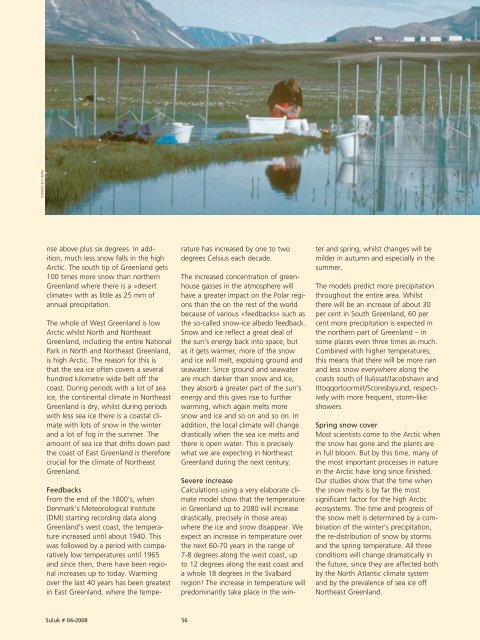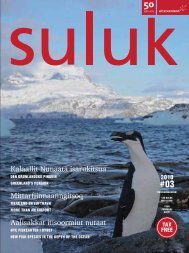Klik her for at se PDF'en - Air Greenland
Klik her for at se PDF'en - Air Greenland
Klik her for at se PDF'en - Air Greenland
You also want an ePaper? Increase the reach of your titles
YUMPU automatically turns print PDFs into web optimized ePapers that Google loves.
THOMAS B.G. BERG<br />
ri<strong>se</strong> above plus six degrees. In addition,<br />
much less snow falls in the high<br />
Arctic. The south tip of <strong>Greenland</strong> gets<br />
100 times more snow than nort<strong>her</strong>n<br />
<strong>Greenland</strong> w<strong>her</strong>e t<strong>her</strong>e is a »de<strong>se</strong>rt<br />
clim<strong>at</strong>e« with as little as 25 mm of<br />
annual precipit<strong>at</strong>ion.<br />
The whole of West <strong>Greenland</strong> is low<br />
Arctic whilst North and Northeast<br />
<strong>Greenland</strong>, including the entire N<strong>at</strong>ional<br />
Park in North and Northeast <strong>Greenland</strong>,<br />
is high Arctic. The reason <strong>for</strong> this is<br />
th<strong>at</strong> the <strong>se</strong>a ice often covers a <strong>se</strong>veral<br />
hundred kilometre wide belt off the<br />
coast. During periods with a lot of <strong>se</strong>a<br />
ice, the continental clim<strong>at</strong>e in Northeast<br />
<strong>Greenland</strong> is dry, whilst during periods<br />
with less <strong>se</strong>a ice t<strong>her</strong>e is a coastal clim<strong>at</strong>e<br />
with lots of snow in the winter<br />
and a lot of fog in the summer. The<br />
amount of <strong>se</strong>a ice th<strong>at</strong> drifts down past<br />
the coast of East <strong>Greenland</strong> is t<strong>her</strong>e<strong>for</strong>e<br />
crucial <strong>for</strong> the clim<strong>at</strong>e of Northeast<br />
<strong>Greenland</strong>.<br />
Feedbacks<br />
From the end of the 1800’s, when<br />
Denmark’s Meteorological Institute<br />
(DMI) starting recording d<strong>at</strong>a along<br />
<strong>Greenland</strong>’s west coast, the temper<strong>at</strong>ure<br />
increa<strong>se</strong>d until about 1940. This<br />
was followed by a period with compar<strong>at</strong>ively<br />
low temper<strong>at</strong>ures until 1965<br />
and since then, t<strong>her</strong>e have been regional<br />
increa<strong>se</strong>s up to today. Warming<br />
over the last 40 years has been gre<strong>at</strong>est<br />
in East <strong>Greenland</strong>, w<strong>her</strong>e the tempe-<br />
Suluk # 04 2008 56<br />
r<strong>at</strong>ure has increa<strong>se</strong>d by one to two<br />
degrees Celsius each decade.<br />
The increa<strong>se</strong>d concentr<strong>at</strong>ion of greenhou<strong>se</strong><br />
gas<strong>se</strong>s in the <strong>at</strong>mosp<strong>her</strong>e will<br />
have a gre<strong>at</strong>er impact on the Polar regions<br />
than the on the rest of the world<br />
becau<strong>se</strong> of various »feedbacks« such as<br />
the so-called snow-ice albedo feedback.<br />
Snow and ice reflect a gre<strong>at</strong> deal of<br />
the sun’s energy back into space, but<br />
as it gets warmer, more of the snow<br />
and ice will melt, exposing ground and<br />
<strong>se</strong>aw<strong>at</strong>er. Since ground and <strong>se</strong>aw<strong>at</strong>er<br />
are much darker than snow and ice,<br />
they absorb a gre<strong>at</strong>er part of the sun’s<br />
energy and this gives ri<strong>se</strong> to furt<strong>her</strong><br />
warming, which again melts more<br />
snow and ice and so on and so on. In<br />
addition, the local clim<strong>at</strong>e will change<br />
drastically when the <strong>se</strong>a ice melts and<br />
t<strong>her</strong>e is open w<strong>at</strong>er. This is preci<strong>se</strong>ly<br />
wh<strong>at</strong> we are expecting in Northeast<br />
<strong>Greenland</strong> during the next century.<br />
Severe increa<strong>se</strong><br />
Calcul<strong>at</strong>ions using a very elabor<strong>at</strong>e clim<strong>at</strong>e<br />
model show th<strong>at</strong> the temper<strong>at</strong>ure<br />
in <strong>Greenland</strong> up to 2080 will increa<strong>se</strong><br />
drastically, preci<strong>se</strong>ly in tho<strong>se</strong> areas<br />
w<strong>her</strong>e the ice and snow disappear. We<br />
expect an increa<strong>se</strong> in temper<strong>at</strong>ure over<br />
the next 60-70 years in the range of<br />
7-8 degrees along the west coast, up<br />
to 12 degrees along the east coast and<br />
a whole 18 degrees in the Svalbard<br />
region! The increa<strong>se</strong> in temper<strong>at</strong>ure will<br />
predominantly take place in the win-<br />
ter and spring, whilst changes will be<br />
milder in autumn and especially in the<br />
summer.<br />
The models predict more precipit<strong>at</strong>ion<br />
throughout the entire area. Whilst<br />
t<strong>her</strong>e will be an increa<strong>se</strong> of about 30<br />
per cent in South <strong>Greenland</strong>, 60 per<br />
cent more precipit<strong>at</strong>ion is expected in<br />
the nort<strong>her</strong>n part of <strong>Greenland</strong> – in<br />
some places even three times as much.<br />
Combined with hig<strong>her</strong> temper<strong>at</strong>ures,<br />
this means th<strong>at</strong> t<strong>her</strong>e will be more rain<br />
and less snow everyw<strong>her</strong>e along the<br />
coasts south of Iluliss<strong>at</strong>/Jacobshavn and<br />
Ittoqqortoormiit/Scoresbysund, respectively<br />
with more frequent, storm-like<br />
showers.<br />
Spring snow cover<br />
Most scientists come to the Arctic when<br />
the snow has gone and the plants are<br />
in full bloom. But by this time, many of<br />
the most important proces<strong>se</strong>s in n<strong>at</strong>ure<br />
in the Arctic have long since finished.<br />
Our studies show th<strong>at</strong> the time when<br />
the snow melts is by far the most<br />
significant factor <strong>for</strong> the high Arctic<br />
ecosystems. The time and progress of<br />
the snow melt is determined by a combin<strong>at</strong>ion<br />
of the winter’s precipit<strong>at</strong>ion,<br />
the re-distribution of snow by storms<br />
and the spring temper<strong>at</strong>ure. All three<br />
conditions will change dram<strong>at</strong>ically in<br />
the future, since they are affected both<br />
by the North Atlantic clim<strong>at</strong>e system<br />
and by the prevalence of <strong>se</strong>a ice off<br />
Northeast <strong>Greenland</strong>.



